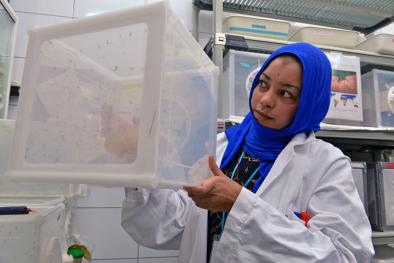Science Source
The potential impacts of 21st century climatic and population changes on human exposure to the virus vector mosquito Aedes aegypti
- States the mosquito Aedes (Ae). aegypti transmits the viruses that cause dengue, chikungunya, Zika and yellow fever
- Investigates how choosing alternate emissions and/or socioeconomic pathways may modulate future human exposure to Ae. aegypti
- Maps, globally, the occurrence patterns for Ae. aegypti for 2061–2080 using empirically downscaled air temperature and precipitation projections from the Community Earth System Model, for the Representative Concentration Pathway (RCP) 4.5 and 8.5 scenarios
- Quantifies population growth using gridded global population projections consistent with two Shared Socioeconomic Pathways (SSPs), SSP3 and SSP5
- Compares change scenarios to a 1950–2000 reference period
- Finds a global land area of 56.9 M km2 is climatically suitable for Ae. aegypti during the reference period, and is projected to increase by 8 % (RCP4.5) to 13 % (RCP8.5) by 2061–2080
- Finds the annual average number of people exposed globally to Ae. aegypti for the reference period is 3794 M, a value projected to statistically significantly increase by 298–460 M (8–12 %) by 2061–2080 if only climate change is considered, and by 4805–5084 M (127–134 %) for SSP3 and 2232–2483 M (59–65 %) for SSP5 considering both climate and population change (lower and upper values of each range represent RCP4.5 and RCP8.5 respectively)
- Results suggest that taking the lower-emissions RCP4.5 pathway instead of RCP8.5 may mitigate future human exposure to Ae. aegypti globally, but the effect of population growth on exposure will likely be larger
- Finds that, regionally, Australia, Europe and North America are projected to have the largest percentage increases in human exposure to Ae. aegypti considering only climate change
Related Content
Science Source
| The Lancet
El Niño and climate change—contributing factors in the dispersal of Zika virus in the Americas? - The Lancet
Shlomit Paz, Jan C Semenza
Science Source
| Proceedings of the National Academy of Sciences
Global risk model for vector-borne transmission of Zika virus reveals the role of El Niño 2015
Cyril Caminade, Joanne Turner, Soeren Metelmann et al
Headline

Apr 7, 2017 | Carbon Brief
Zika outbreak ‘fuelled by’ El Niño and climate change
Science Source
| MMWR. Morbidity and Mortality Weekly Report
Vital Signs: Update on Zika Virus–Associated Birth Defects and Evaluation of All U.S. Infants with Congenital Zika Virus Exposure — U.S. Zika Pregnancy Registry, 2016
Megan R. Reynolds, MPH; Abbey M. Jones, MPH; Emily E. Petersen et al


